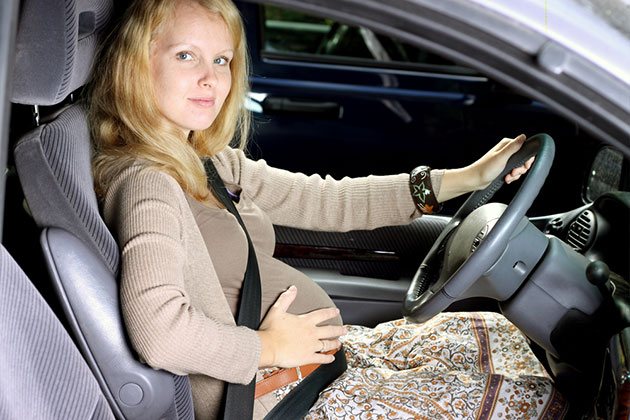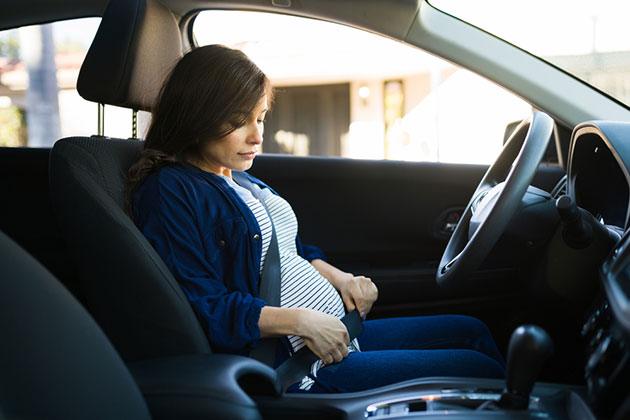As a mom-to-be, you are often unsure whether you can do the regular daily tasks you once did.
Can you eat spicy food, can you practice yoga, enjoy an occasional glass of wine? The list goes on and on, and these are all valid concerns of a future mom.
But there is one thing that pregnant women are allowed to do with extra precaution - it's driving while pregnant.
No one said you have to take the passenger seat once you are pregnant. However, you need to know a few guidelines and safety tips before getting behind the steering wheel.
Seat belts save thousands of lives throughout the year, but how do you wear one while pregnant?
We answer this and many more dilemmas you may have while expecting!
More...
Driving While Pregnant: A Safety Risk or a Not?

Let's start with the most common question expecting mommas have: Is it safe to drive in your condition?
In most cases, it's safe.
If your chosen doctor or a specialist has forbidden you from driving for medical reasons, you must stick to their recommendations.
Such medical concerns may include nausea, anemia, diabetes, or high blood pressure.
If you plan to be an active driver, we would advise you to consult with your specialist and check whether it's 100% safe to get behind the steering wheel.
Only after that are you ready to learn all about safe driving during pregnancy.
However, there are certain risks, and they increase if you are not properly restrained or distracted while driving.
According to NHTSA, around 3,142 drivers and passengers were fatally injured by distracted driving only in 2019!
Anything that diverts your attention while driving can cause a major risk to both you and your baby.
A popular Canadian study finds that women in their second trimester are at greater risk by 42% of fatal injuries. Yes, you read that correctly.
The second trimester is where you should be the most observant and drive with caution. The first and third trimesters did not present that much risk for many women.
Tips for Safe Driving
1. Put away your cell phone!
The constant ringing and notifications can mess with your perception and distract you from keeping your eyes on the road.
When driving during pregnancy, put the phone on silent and focus on the well-being of the little passenger inside you.
2. Check your medications.
A few of the prescribed medications declare you should not be operating a vehicle while using them.
Follow all the guidelines and recommendations of your doctor, as they often can interfere with your driving capacity.
3. Rest well
If you are feeling fatigued, nauseous, or swollen, it's best to skip the driver duty for the day.
These pregnancy symptoms may seem harmless when you are in the comfort of your home, but behind the wheel, you must be 100% sane.
Seat-Belts & Steering Wheel Adjustments

Not wearing a seat belt during pregnancy is a common misconception!
Many pregnant drivers may think that you are putting pressure on the tummy by wearing the seat belt and may even go into preterm labor. This is not the case.
Not wearing a seat belt while driving is half times a leading cause of serious car accidents.
Although it's common car seat mistakes of pregnant drivers, let's see how you should wear a car seat while pregnant.
1. How to Properly Wear a Seat Belt While Pregnant?
Understandably, a lot of future moms will fear the seat belt.
Will it press the tummy, will it hurt, or will you be able to reach the steering wheel while being restrained with a lap and shoulder belt?
Here is how to properly secure a seat belt and keep the baby healthy!
For starters, you need to be using a three-point restraint. The upper strap should be at the shoulder joint.
Don't slide the shoulder belt down.
Most women will try to make themselves comfortable while driving by moving the shoulder belt down a bit, but this is a big no-no.
The top portion should come down between the breast tissue and under the breast bone and move to the side of the tummy.
Never put the seat belt over the belly! The impact of the seat belt can cause pressure and put both you and the baby at risk.
The lower strap needs to go under the belly and over the hip bones and upper thighs. The lap portion of the belt should not be putting pressure on the belly.
Also, make sure you are dressed lightly.
A bulky coat or a jacket can often interfere with the proper seat belt installation.
If you are still not comfortable with the seat belt or not securing you entirely, consider purchasing a seat belt positioner.
Or, you can try a Tummy Shield. It's a pregnancy seat belt adjuster that has been crash-tested. The patented design works by securing and avoiding the tummy area at the lap.
Take a look at the demonstration video.
2. How to Adjust the Steering Wheel While Pregnant?
Although it may feel more comfortable to ride close to the wheel, it can present a significant safety hazard in a car crash.
The seat should be slightly far apart, and there should be at least 10 inches between your breast and the wheel.
Also, try moving the steering wheel upward.
Of course, you should not be too far apart when fixing the seat. However, you should still be able to reach the bottom pedals comfortably.
Should You Continue Using Air Bags While Pregnant Driving?
The air-bag system raises a few valid concerns among our pregnant mommas.
First, if it does go off in traffic accidents, will it cause more harm than good?
The answer is NO!
Driving pregnant, you should never disable the airbag system.
The airbag has come a long way in developing a fine protective shield that works along with the seat belt.
If your car does not have airbags in the back seat and you are not driving at the time, it's best to sit in the passenger driver's seat.
How to Take Long Trips While Pregnant?

If you have a long road ahead of you, it's possible to manage it during pregnancy.
However, whether you are the driver or passenger, there are a few tips & guidelines you need to know about.
The first of them is taking frequent pit stops. Every hour or so, stop and get out of the car.
As you know, pregnancy carries with itself a lot of back pain and swelling. For this reason, it's essential to take pauses and stretch your legs to get the blood flowing.
Snacks save the day!
It's stressful enough we get to deal with hormones, but to survive the long road trip without your favorite snack? No way!
Remember to drink plenty of water; we want to keep hydration at an optimal level.
Don't exaggerate with the driving time!
The maximum should be around 6 hours, with the rest included. However, if you feel like that is too much for you, listen to your body.
Like we mentioned previously, wear loose-fitting clothes no matter the season.
If you are driving the car, bulky clothes can interfere with the further protection of the seat belt.
Is There a Prefered Time for Driving During Pregnancy?
Many women will not feel uncomfortable driving or performing other normal human activities even days before their due date.
However, most will experience discomfort while sleeping, sitting, or even walking, let alone getting behind the wheel.
If you asked us the best time to drive or even travel, we would have to say it's the second trimester.
This is when your morning nausea gets weaker and almost wears off, so it will be manageable to handle longer trips.
Should You Contact Your Doctor if You Get in a Minor Fender Bender?
Sudden braking can cause injuries such as separating the placenta from the uterus, let alone getting in a traffic accident.
The pelvic floor will offer protection in your first trimester by expanding for the growing baby.
In your second trimester, the amniotic sac protects the baby from injuries and regulates the temperature of the fetus.
However, if you get in a minor accident, visit your doctor right away!
Many pregnant occupants will feel fine and not report the issue, while in reality, you may experience severe trauma.
Car crashes continue to be the leading cause of fatal outcomes. A fetus is fifteen times more likely to die from car crashes than a pre-teen from a firearm accident.
For this reason, it's always best to be safe than sorry, even if there is nothing to worry about.
Should You Drive After Giving Birth?

After delivering a baby into the world, you should give your body some time to heal.
Passionate drivers cannot wait to get behind the wheel again, but don't rush things!
If you had a tough vaginal delivery or a C-section, it's best to recover for at least 2-3 weeks.
Dr. Robert Atlas at Mercy Medical Center in Baltimore says that you need all of your core strength to hit the brakes after postpartum, so it's essential to recover fully.
Since you will be visiting the pediatrician for check-ups, it's best to ask your partner or friend to drive you.
FAQs
When should a pregnant woman stop driving?
A pregnant woman should stop driving as soon as she no longer feels capable of managing the vehicle.
Don't get in the driver's seat if you feel weak, experience nausea, or can no longer reach the breaks and the steering wheel.
Driving during pregnancy is totally fine if you drive safely and follow the right guidelines.
Is driving bad for a pregnant woman?
Most of the time, driving is not bad for pregnant women as long as they do safely and properly wear a seat belt.
However, do not drive if your specialist forbids you for medical reasons or if you cannot get in a safe position.
Is it safe to drive on a bumpy road while pregnant?

Your baby is safer than you may think.
However, driving on a bumpy road is not preferred while pregnant.
Other women may not experience any issues, while some may suffer from abdominal pain, abnormal fetal heart rate, and other minor injuries.
When going over a bumpy road, it's best to slow down to up to 25 km/h.
In this way, you reduce the possibility of a serious injury to an unborn child.
Can you drive a car 9 months pregnant?
As long as you can reach the steering wheel, pedal breaks, and properly wear a seatbelt, you can drive a car at nine months pregnant.
How far can pregnant drive?
Generally, you don't have to stop driving during pregnancy unless you notice a change in demeanor.
This includes not reaching the pedal breaks, not wearing a seatbelt, or experiencing health issues.
Can I drive myself to the hospital in labor?
No, you should not drive yourself to the hospital in labor!
This counts as distracted driving, and you are in no good condition of managing a vehicle.
If you get in the labor while driving, make a pit stop, call an ambulance or a friend to drive you to the hospital safely.
Final Words
They don't say moms are superheroes for no reason!
Suppose you do decide to get behind the wheel and take the driver's role with a baby bump in your way; kudos to you!
However, remember that you need to follow the safety rules listed above.
Wear your seatbelt correctly, stay away from the cell phone and listen to your body!
If you can drive the long road ahead and still manage to reach all the parts of your seat and drive without movement limitations, who are we to stop you?
You go, momma!
